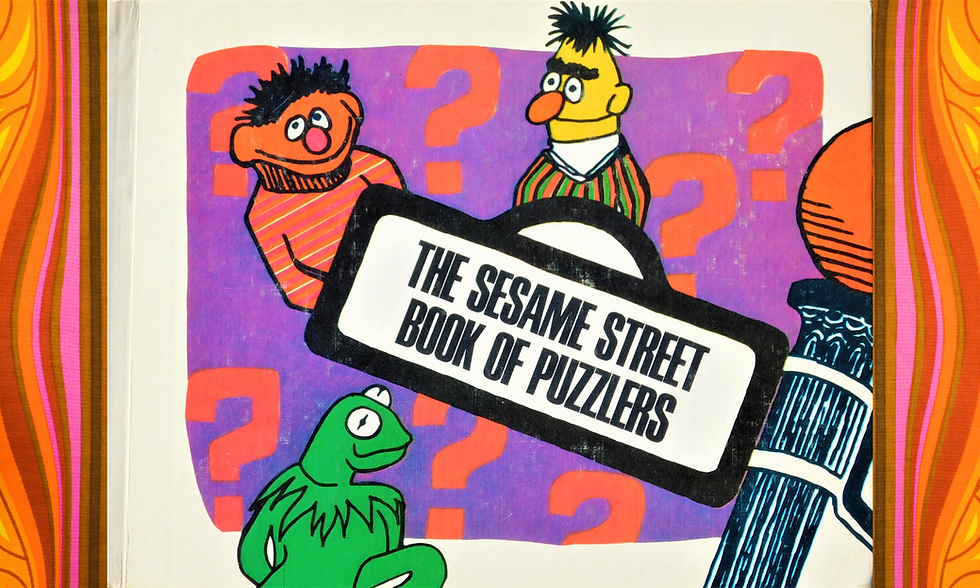The Sesame Street Book of Puzzlers
- Marshall Ward

- Mar 22, 2023
- 3 min read
I think about how many millions of us learned important lessons from Sesame Street, writes Marshall Ward

I love old-school Sesame Street. I loved it as a kid, as a father, and as someone who loves the show's inspiring legacy.
My Bonn Park podcast co-host Sara loves Sesame Street too and owns an original 1981 copy of the book Christmas Eve on Sesame Street from her childhood. We've talked a LOT about Sesame Street on the podcast, and our Bonn Park logo is an homage to arguably the most important children’s program in the history of television — which first aired on Nov. 10, 1969.
So I was delighted when I stumbled on a 1970 book at an antique shop called The Sesame Street Book of Puzzlers.
The book features beautiful photos and illustrations from Sesame Street and challenges kids with questions like, “Can you tell which shape is not like the others?” “How many wrong things can you see in these pictures?” and “How would you arrange these circles if you wanted them in order by size?”
When my kids were little, we watched DVDs covering the show's first 20 years (1969-1989) and read countless Sesame Street books from my childhood.
Created by the visionary genius of Jim Henson and Frank Oz, the show took place in an inner-city neighbourhood filled with magical characters like Mr. Hooper, Big Bird, Oscar the Grouch, Ernie and Bert, Cookie Monster, Grover, Prairie Dawn, and Kermit the Frog.
When I started watching it as a young child in the ‘70s, it was already decades ahead of its time. The colourful and curious Muppets asked intelligent questions about the larger world beyond their home, and Henson’s characters taught me not only about dignity and respect for individuals, but also about respect for different cultures.
I still love watching old episodes of Sesame Street for the classic skits and animated segments, like the fascinating and weird psychedelic pinball cartoon that taught me and kids everywhere the numbers one through 10.
My favourite song was “Ladybugs’ Picnic” from the early days of Sesame Street, featuring 12 ladybugs gathered for a picnic, sung by folk singer Jim Kweskin.
And the “King of Eight” segment would scare the life out of me with that crazy jester at the end delivering the news of a ninth princess on the way.
What I especially love about collecting the classic Sesame Street books from the ‘70s and ‘80s is they are full of retired characters like Sherlock Holmes, The Amazing Mumford, Don Music, Guy Smiley, the Twiddle Bugs, Sully and Biff, Roosevelt Franklin, and Frazzle.
For years, I enjoyed pulling out my favourite childhood record, “The Sesame Street Fairy Tale Album” from 1977, and loved the experience of sharing these stories with my kids – remembering back to when I played this album on my Fisher Price turntable every night for years.
I am certain that what made Henson’s characters stand the test of time is they were empathetic, caring, and multi-faceted. Bert was cranky but could be kind and sweet. Ernie was naïve but full of curiosity; Grover was neurotic but so loving and sharing.
As a grownup, I now appreciate the sophisticated humour that classic Sesame Street offered to older viewers, with numerous spoofs and parodies on popular culture. The show is a beautiful snapshot of its time, but still as relevant as ever.
Sesame Street not only entertained and helped kids like me learn the fundamentals of reading and arithmetic, but also inspired us to sing and dance.
When I look through my new (old) book of Sesame Street puzzlers, I think about how many millions of us learned important lessons from Sesame Street.
I think it still has much to teach all of us.




Comments